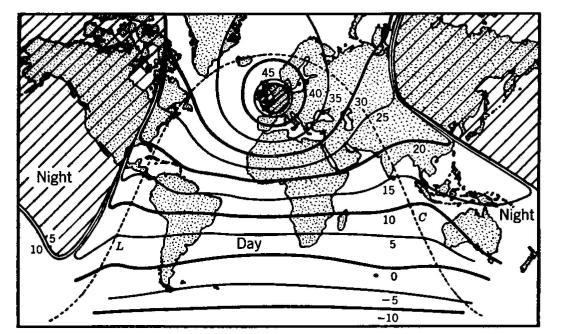| Electrical Communication is a free textbook on the basics of communication technology. See the editorial for more information.... |

|

Home  Radio Wave Propagation and Antennas Radio Wave Propagation and Antennas  Sky-Wave Propagation Sky-Wave Propagation |
|||||||






|
|||||||
Sky-Wave PropagationSky-wave reflection occurs at very low frequencies (10 to 30 kilocycles) and into the low-frequency range (30 to 300 kilocycles). The waves at the lower frequencies are propagated through space somewhat as if bounded by two spherical reflecting shells, the ionosphere and the earth.6 Energy loss in both the earth and the ionosphere is small. Absorption by the ionosphere becomes important, particularly in daytime, in the medium-frequency band (300 to 3000 kilocycles) and the upper part of the low-frequency band. At the standard amplitude-modulation frequencies of 550 to 1600 kilocycles, only the ground wave need be considered in the daytime. During daytime, absorption occurs in the E layer. During the night, and particularly in the winter, the decrease in density of ionization and the resulting reduction in absorption by the E layer cause reflection to occur. It is difficult to calculate with accuracy the strength of the sky-wave signal, but it can be estimated,6 assuming a reflection coefficient of about 0.25. Curves are given in reference 16 by which sky-wave field intensities can be determined for the standard broadcast band. If a radio station is receiving a signal by both the ground-wave path and the sky-wave path, then the received signal is the vector sum of the two components. Sky-wave signals are erratic, and, whenever they are involved, variations in signal strength occur. This is called fading and is defined1 as "variation of radio field intensity caused by changes in the transmission medium." Sometimes, selective fading occurs,24 defined1 as "fading which is different at different frequencies in a frequency band occupied by a modulated wave." In the high-frequency band (3 to 30 megacycles) the ground wave is absorbed so rapidly that usually only sky-wave transmission is important. An exception is for such purposes as city police radio systems and installations where the antennas are at a distance above the earth. In such instances space-wave transmission is important. But, for strictly sky-wave propagation, the transmission is so erratic that calculations are unreliable, and curves and maps with field-strength contours are used,6,8,22 an example being Fig. 10.
In fact, as Dellinger has stated,8 "The more one views the complexities of radio transmission via the ionosphere, the more he marvels that it provides any intelligible communication."(1) Only because of exhaustive studies25,26,27 over long periods has sky-wave communication been made useful. Depending on conditions, above about 30 megacycles reflection from the ionosphere becomes uncertain, and above about 60 megacycles reflection from the ionosphere rarely occurs. Thus, at very high frequencies (30-300 megacycles) transmission is normally by the space wave.
|
|||||||
Home  Radio Wave Propagation and Antennas Radio Wave Propagation and Antennas  Sky-Wave Propagation Sky-Wave Propagation |
|||||||
Last Update: 2011-05-30


